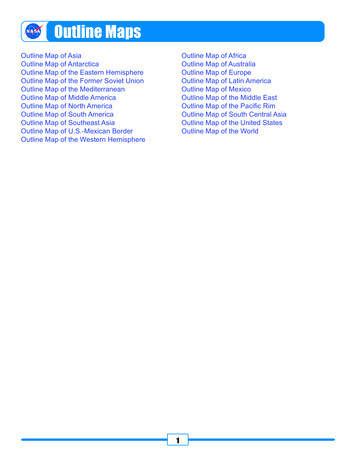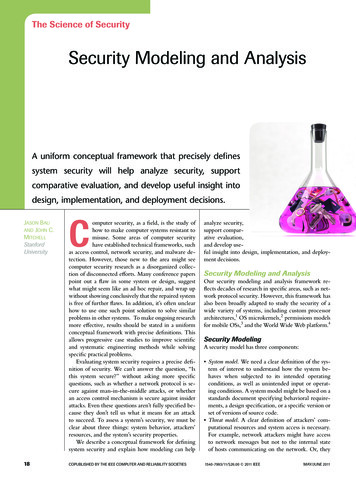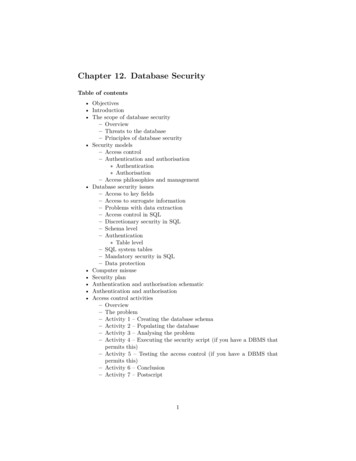
Transcription
Security AnalysisCourse Outline and Course SyllabusI. COURSE IDENTIFICATIONCourse Code:SECURAN (FM31)Course Title:Security AnalysisCourse Description:This course focuses on the fundamental principles andtechniques of security analysis. The course will deal withthe following topics: definition of securities; securitiesregulation in the Philippines; the investmentenvironment; markets and instruments; macroeconomicand industry analysis; fundamental analysis; technicalanalysis; equity valuation models; financial statementanalysis; derivatives instruments; and special topics.Credit:3 unitsPrerequisite:Investment Portfolio ManagementSchedule:Room:
II. COURSE OBJECTIVESA.GENERAL OBJECTIVEThis course is designed to provide the students with the basic principles andtechniques of security analysis including securities trading and regulation.B.SPECIFIC OBJECTIVESUpon completion of this course, the students are expected to:1.2.3.4.5.6.7.Have a firms grasp on the concepts of securities;Be knowledgeable on the different markets and instruments;Have a general understanding on securities trading and regulation;Be knowledgeable on macroeconomic, industry, fundamental and technicalanalysis;Have a general understanding of equity valuation models and financialstatement analysisAppreciate other topics related to security analysis.Obtain additional professional certification through the Bloomberg MarketConcepts (BMC) certification module. This certification gives students anedge in their career in finance as Bloomberg Terminal is the widely-usedfinancial information database by finance professionals globally.- BMC is an 8-hour self-paced e-learning course that provides a visualintroduction to the financial markets. BMC consists of four modules –Economics, Currencies, Fixed Income and Equities.III. COURSE SYLLABUSWeek1TopicsINTRODUCTION- Orientation- Review of the Course Syllabus- Setting of expectations in class- Preliminary Discussions
2&34&56&789INVESTMENT ENVIRONMENT, MARKETS AND INSTRUMENTS- Real versus Financial Assets- Financial Markets and the Economy- Clients of the Financial System- Markets and Market Structure- The Money Market- The Bond Market- Equity Securities- Market Indexes- Derivatives MarketsSECURITIES- What are Securities- Investment Banking- Securities Trading- Trading Participants- Local Exchanges (PSE, PDEx)- Foreign ExchangesSECURITIES REGULATION- The Securities and Exchange Commission- The International Organization of Securities Commissions- Registration of Securities- Investor Protection- Manipulation of Security Prices- Insider Trading- Tender Offer- White Collar Crimes Related to Securities- MIDTERM EXAMINATION- Introduction/discussion of the Bloomberg Market Concepts (CertificationModule)MACROECONOMIC AND INDUSTRY ANALYSIS- Global Economy- Domestic Economy- Fiscal, Monetary and Supply-Side Policies- Business Cycle- Industry Analysis- Industry Life Cycle- Industry Structure and Performance
1011121314EQUITY VALUATION MODELS- Balance Sheet Valuation Methods- Intrinsic Value versus Market Price- Dividend Discount Model- Price-Earnings Ratio- Corporate Finance and Free Cash Flow Approach- Inflation and Equity ValuationTHE AGGREGATE STOCK MARKET- Fundamental Analysis- Technical Analysis- Explaining Past Behavior- Forecasting Models- Market AnomaliesFINANCIAL STATEMENT ANALYSIS- The Major Financial Statements- Accounting versus Economic Earnings- Return on Equity- Ratio Analysis- Economic Value Added- Comparability ProblemsSPECIAL TOPICS- Derivatives- Global Trends- New Market Instruments- Thematic Investing (Ethical Investing, Islamic Equity Funds)FINAL EXAMINATIONIV. Instructional Strategies and Techniques1.2.3.4.5.Lectures and class discussionsRecitationsProblem SetsGroup PresentationsBloomberg Market Concepts (Certification Module) – requires completion of theBMC certification online.- Additional examination requirement to test the knowledge obtained by thestudents who finished BMC module.6. Major examsV. Reference Materials
Bodie, Z., A. Kane and A.J. Marcus. (2002). Investments. New York: McGraw-Hill Companies, Inc.Decasa, L.M. (2013). Securities Regulation Code (Republic Act No. 8799): Annotated withImplementing Rules and Regulations. Manila: Rex Book Store.Graham, B. and D.L. Dodd. (2009). Security Analysis: Principles and Technique. New York:McGraw Hill Companies, Inc.Reilly, F.K. and K.C. Brown. (1997). Investment Analysis and Portfolio Management. Fort Worth:The Dryden Press.Ross, S.A., R.W. Westerfield and J. Jaffe. (1999). Corporate Finance. New York: McGraw-HillCompanies, Inc.Other Materials – To be announced.VI. Grading SystemTwo Major ExaminationsIndividual Outputs (Recitations, Quizzes, Participation)Group Outputs (Presentations, Problem Sets)TOTALBloomberg Market Concepts (Certification Module) - BONUSVI. Instructor’s InformationNameEmail addressContact numberConsultation Hours::::40%35%25%100% 10%
Security Analysis Course Outline and Course Syllabus I. COURSE IDENTIFICATION Course Code : SECURAN (FM31) Course Title : Security Analysis Course Description : This course focuses on the fundamental principles and techniques of security analysis. The course will deal with the following topics: definition of securities; securities .










